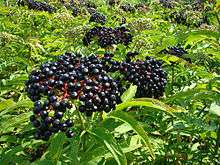Sambucus ebulus
| European dwarf elder | |
|---|---|
 | |
| Danewort inflorescence | |
| Scientific classification | |
| Kingdom: | Plantae |
| (unranked): | Angiosperms |
| (unranked): | Eudicots |
| (unranked): | Asterids |
| Order: | Dipsacales |
| Family: | Adoxaceae |
| Genus: | Sambucus |
| Species: | S. ebulus |
| Binomial name | |
| Sambucus ebulus L. | |
| Synonyms[1] | |
| |

Sambucus ebulus, also known as danewort, dane weed, danesblood, dwarf elder or European dwarf elder, walewort,[2] dwarf elderberry,[3] elderwort and blood hilder is a herbaceous species of elder, native to southern and central Europe and southwest Asia. The species is also reportedly naturalized in parts of North America (New York, New Jersey and Québec).[4]
Description
Sambucus ebulus grows to a height of 1–2 m and has erect, usually unbranched stems growing in large groups from an extensive perennial underground stem rhizome. The leaves are opposite, pinnate, 15–30 cm long, with 5-9 leaflets with a foetid smell. The stems terminate in a corymb 10–15 cm diameter with numerous white (occasionally pink) flat-topped hermaphrodite flowers. The fruit is a small glossy black berry 5–6 mm diameter. The ripe fruit give out a purple juice.[2] [5]
The name danewort comes from the belief that it only grows on the sites of battles that involved the Danes.[2] The term 'walewort' or 'walwort' meant 'foreigner plant.' The plant's stems and leaves turn red in autumn and this may explain the link with blood. The word Dane may link to an old term for diarrhoea.[2]
Uses
Sambucus ebulus fruits have been used in the traditional Austrian medicine for treatment of disorders of the respiratory tract and fever.[6]
References
- ↑ The Plant List
- 1 2 3 4 Westwood, Jennifer (1985). Albion. A Guide to Legendary Britain. London : Grafton Books. ISBN 0-246-11789-3. p. 103
- ↑ "Sambucus ebulus". Natural Resources Conservation Service PLANTS Database. USDA. Retrieved 28 October 2015.
- ↑ BONAP (Biota of North America Project) floristic synthesis, Sambucus ebulus
- ↑ Clapham, A.R., Tutin, T.G. and Warburg, E.F. 1968. Excursion Flora of the British Isles. Cambridge University Press. ISBN 0 521 04656 4
- ↑ Vogl S, Picker P, Mihaly-Bison J, et al. (October 2013). "Ethnopharmacological in vitro studies on Austria's folk medicine—An unexplored lore in vitro anti-inflammatory activities of 71 Austrian traditional herbal drugs". Journal of Ethnopharmacology. 149 (3): 750–71. doi:10.1016/j.jep.2013.06.007. PMC 3791396
 . PMID 23770053.
. PMID 23770053.
External links
| Wikimedia Commons has media related to Sambucus ebulus. |